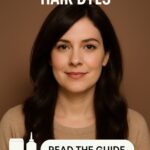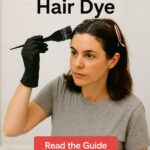
Permanent color is the workhorse of at-home hair dye. It uses oxidative dye and developer to open the cuticle, place color inside the hair, and lock it in. Pick well and you get rich, believable tone that lasts, plus real gray coverage. The trick is choosing the right level, the right tone family, and a formula that treats your hair kindly. This guide keeps it simple. You will find four dependable picks, a quick comparison table, pro-level application steps, and an easy maintenance plan so your shade stays glossy instead of fading warm by week five.
Quick Comparison Table
Below is a fast way to decide based on your hair goal. Level 4 to 6 covers most natural brunettes, 7 to 9 hits dark to light blonde. If you are between levels, choose the lighter box first because permanent color reads darker on porous ends. Always strand test and time to the minute.
| Pick | Type & Shade Range | Why it is great | Keep in mind |
|---|---|---|---|
| L’Oréal Paris Superior Preference | Permanent, wide range from Level 3 to 10, multiple tones | Dimensional results with shine serum and fade-defying system | Strong lift on fine hair, watch timing on lengths |
| Clairol Nice’n Easy | Permanent, neutral to warm and cool in every level | Natural-looking tones and reliable gray coverage for everyday color | Can deepen on porous ends if pulled through too long |
| Schwarzkopf Keratin Color | Permanent, neutral and cool shades, built-in pre-treatment | Great for stubborn grays, smoother feel after coloring | Slightly thicker cream, take time to saturate |
| Garnier Nutrisse | Permanent, Level 3 to 9, neutral and warm browns and blondes | Oil-enriched formula that leaves lengths soft and shiny | Fragrance is noticeable if you are scent sensitive |
The Best Permanent Hair Dyes
Ratings reflect a summary of owner feedback and stylist commentary.
1) L’Oréal Paris Superior Preference — Best overall for believable, glossy color
Rating: 4.7/5
Why we picked it
Preference balances staying power with a more dimensional finish than many kits. The gel-cream spreads easily, which helps you saturate mid-lengths without dripping. The after-color care leaves a mirror finish that reads healthy in daylight rather than matte. Shade coverage is broad, so you can go from cool brunettes to champagne blondes without hunting for a match.
How to use for best results
Start with four clean sections. On virgin hair that is two levels lighter than your target, apply to mid-lengths first, then roots, and pull through ends for the final 5 to 10 minutes. For gray coverage on previously colored hair, start at roots and keep lengths protected with a little conditioner until the final few minutes. Rinse cool, then use the included conditioner to seal the cuticle.
Keep in mind
Preference can lift quickly on fine hair with 20-volume developer. If your hair feels delicate, reduce the pull-through time on the ends and leave a small buffer before the full root time is up.
Best for
Anyone who wants a salon-style, light-reflective result at home and a shade library that actually fits real heads of hair.
Pros
- Dimensional finish that resists dullness
- Even saturation with a gel-cream texture
- Excellent tone range in cool, neutral, and warm
Cons
- Can over-darken porous ends if you over-process
- More expensive than basic kits
2) Clairol Nice’n Easy — Best everyday kit with reliable gray coverage
Rating: 4.6/5
Why we picked it
Nice’n Easy is the classic for a reason. It covers grays without turning them flat and keeps brunette and blonde families looking natural. The tones feel believable under indoor and outdoor light, and the post-treatment leaves hair soft for the first week when color can feel a bit rough.
How to use for best results
If gray coverage is your goal, paint the root area first and keep a strict 30 to 35 minute window on resistant areas like the temple and front hairline. For previously colored lengths, refresh only in the last 5 to 10 minutes. The included conditioner pairs well with a cool rinse to help lock down the cuticle.
Keep in mind
Because the system covers well, it can stack quickly on mid-lengths if you drag color through every month. Rotate with root-only applications and use a gloss between full processes.
Best for
Natural-looking color shifts and dependable gray coverage without a complicated routine.
Pros
- True-to-box natural tones
- Friendly to first-timers, easy clean-up
- Solid gray coverage
Cons
- Can band on lengths if you reapply too often
- Neutral tones still fade warm without basic UV and heat care
3) Schwarzkopf Keratin Color — Best for stubborn grays and smoother feel
Rating: 4.6/5
Why we picked it
Keratin Color includes a pre-treatment that helps even out porous zones, which leads to better root coverage and fewer dark ends. The cream is thick, so it stays where you put it and gives you time to methodically work through the head. Results skew salon-polished, especially in the cooler brown families that help fight brass.
How to use for best results
Massage the pre-treatment into mid-lengths and ends first. Apply color to the most resistant grays at the front hairline and crown, then finish the back. Take small sections and apply generously. If your ends are very porous, skip the pull-through or give them only 3 to 5 minutes.
Keep in mind
The thicker texture needs patience to spread. Use a tint brush and bowl if the applicator bottle feels slow.
Best for
Coarser or gray-resistant hair that still wants a soft, smooth finish and fewer hot roots.
Pros
- Pre-treatment evens porosity
- Strong gray coverage without straw-like feel
- Cool tones that reduce red shift
Cons
- Heavier cream requires careful sectioning
- Shade range is smaller than L’Oréal
4) Garnier Nutrisse — Best nourishing permanent color on a budget
Rating: 4.5/5
Why we picked it
Nutrisse leans into conditioning oils, which helps colored hair feel flexible and less crispy after rinse-out. Browns and dark blondes look multi-tone, not ink-flat, and the included conditioner is one people actually like to keep using for the next few washes.
How to use for best results
For a full color change, apply to mid-lengths first, then roots, then ends for the final stretch. For routine touch-ups, do roots only, then refresh the last 5 minutes. Work in fine sections and squeeze the bottle along the part while lifting with the nozzle to avoid missed patches.
Keep in mind
The fragrance is noticeable. If you are very scent sensitive, test before committing to a full application.
Best for
Anyone who wants a kinder feel on lengths without sacrificing true permanent coverage at the roots.
Pros
- Soft post-color feel
- Moves nicely through hair, good saturation
- Good value for the result
Cons
- Scent may bother sensitive users
- Warm families can drift red without monthly glossing
How To Choose The Right Permanent Shade
Start with level. Level 1 is black, level 10 is pale blonde. Most people sit between 3 and 8. If you are new to coloring, pick the lighter of two possible shades because permanent formulas deposit quickly and porous ends drink color. Next, pick tone. Neutral keeps things classic and is the safest choice for beginners. Cool neutral fights brass and reads modern under daylight. Warm gives glow but can lean red by week four if you do not gloss. Gray coverage calls for permanent color at the roots and strict timing. If you like a softer hairline, blend a demi or gloss through the lengths after rinsing the root color. Finally, consider maintenance. Daily washers and heat stylers should plan on a monthly gloss and color-safe products to preserve tone.
Pro Application Plan That Avoids Bands
Section your hair into four quadrants, then split each quadrant into horizontal slices as you go. Apply to the highest-priority area first. For gray coverage on previously colored hair, that means roots. For virgin hair that is going darker, start in the mid-lengths where the cuticle is tightest, then go back to the roots, then give the ends only a few minutes. Use a timer. Under-saturation creates miss spots and banding, so load the brush or bottle generously. Wipe stray color from skin as you work with micellar water or petroleum jelly on a cotton swab so you do not end up with a tinted hairline. After the final rinse, use the post-color conditioner and cool water. Wait 48 hours before your next shampoo so the oxidative dyes finish settling.
Color Care That Keeps Tone Honest
Permanent color fades warm because everyday washing, sun, and heat lift the cuticle and expose underlying pigment. Switch to a low-sulfate, color-safe shampoo and wash fewer times per week. Add a UV protectant or a heat protectant when you blow dry or iron. Once every three to four weeks, use a chelating or clarifying wash to remove mineral build-up, then follow with a hydrating mask. A monthly brunette or blonde gloss restores shine and nudges tone back where you want it. If your water is hard, a simple shower filter helps a lot. Keep hot tools in the healthy range and let a round brush or boar-mix brush do more of the smoothing.
Pros and Cons of Permanent Dye
Pros
- Real gray coverage with long-lasting tone
- Broadest shade selection for natural-looking results
- Works with root-only maintenance to protect lengths
Cons
- Higher risk of over-darkening porous ends
- Warm fade by week five without basic glossing and UV care
- Requires strict sectioning and timing to avoid banding
Final Thoughts
Permanent dye is still the best at-home option when you want durable gray coverage and a true color change. Pick the right level, choose neutral or cool tones if you fear brass, and apply with a plan. Root-only applications plus a monthly gloss keep lengths healthy and tone believable. If you treat color like a system rather than a single box, you will get salon-like results at home with far less guesswork.
See also
If you are mapping your full color plan, start with Best At-Home Hair Dye, our router page that explains developers, sectioning, and aftercare in plain language. If you need lift before going lighter or want to fix banding, Best Hair Bleach walks through safer lifts and bond care so you do not torch your ends. Stains happen, so keep How to Get Hair Dye Off Skin handy for clean hairlines on color day. To preserve tone in the shower, our Best Shampoos for Colored Hair guide explains what to use and when. If you prefer a brand routine for color maintenance, read the Redken Color Extend Shampoo Review before you stock up.
FAQs
1) What developer should I use with permanent color?
Most box kits include 20-volume developer, which covers grays and shifts color one to two levels. Stronger lift is risky at home. If you need to go much lighter, use a controlled lift instead of stacking higher developer on the scalp.
2) How often should I recolor my roots?
Every 4 to 6 weeks works for most people. Use a dedicated root kit at week 4 if grays flash at your part. Only refresh the lengths for a few minutes when they look faded.
3) Can permanent dye cover stubborn grays completely?
Yes, with strict timing and full saturation. Target the most resistant areas first, usually the front hairline and crown. If you still see sparkles, try a neutral base shade in the same level or a brand made for resistant grays.
4) Why did my hair turn too dark?
Ends are porous and grab pigment. Next time, keep color off the ends until the final minutes, or use root-only applications and a gloss for the lengths. A clarifying wash and a hydrating mask can soften an overly dark result.
5) How do I stop color from fading warm?
Wash less often with color-safe products, protect from heat and sun, and use a monthly toning gloss. A chelating wash every few weeks clears minerals that make color look muddy or orange.
Affiliate Disclosure
If you purchase through links on our site, we may earn a small commission at no extra cost to you.




